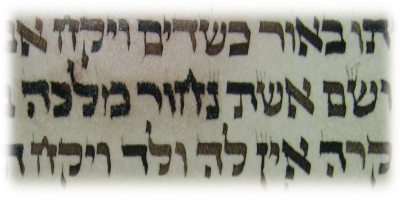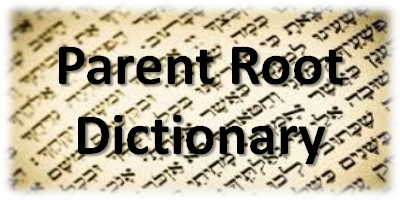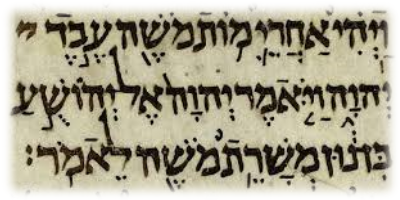The Proto-Semitic language was originally written with pictographs (picture writings), such as in the letter/pictograph  , a picture of the hand. The Semitic word for a "hand" is yad and is the name of this letter, which represents the phonetic sound "Y." Each letter/pictograph in the Hebrew alphabet represents an idea. In the case of the letter
, a picture of the hand. The Semitic word for a "hand" is yad and is the name of this letter, which represents the phonetic sound "Y." Each letter/pictograph in the Hebrew alphabet represents an idea. In the case of the letter  , it represents "work," the function of the hand.
, it represents "work," the function of the hand.
When two letters/pictographs are put together, a Parent Root word is formed. When the  (B - beyt, a house) is combined with the
(B - beyt, a house) is combined with the  (N - nun, a seed which continues the next generation) the Parent Root
(N - nun, a seed which continues the next generation) the Parent Root 

Another example is the Parent Root 

 , (the letter shin), is a picture of the two front teeth meaning "sharp" and the
, (the letter shin), is a picture of the two front teeth meaning "sharp" and the  , the letter pey, is a mouth. This Parent Root means "a sharp mouth" or simply "a serpent," whose sharp fangs are in the mouth.
, the letter pey, is a mouth. This Parent Root means "a sharp mouth" or simply "a serpent," whose sharp fangs are in the mouth.
When we wish to find the definition of an English word we go to a dictionary. While this is also true with Hebrew words, there are additional methods of determining the meaning of a Hebrew word. One such method, which has been previously demonstrated, is to examine its roots which provide additional insight into that word.
Examples of Parent Roots
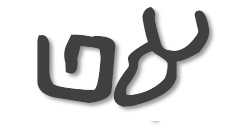
The Hebrew biliteral root A-B
The Hebrew word 

 (aleph) and the
(aleph) and the  (beyt). In Hebrew, the word "aleph" means "ox" and the original pictograph of this letter is an image of an ox head, which represents the idea of "strength." The beyt, a Hebrew word meaning "tent" or "home," is an image of a tent, the home. When the meaning of these two letters are combined we have the "the strength of the tent" and is descriptive of the tent poles which provide strength to the tent. As the beyt can also represent the home, this word also means "the strength of the home," and is the Hebrew word for "father."
(beyt). In Hebrew, the word "aleph" means "ox" and the original pictograph of this letter is an image of an ox head, which represents the idea of "strength." The beyt, a Hebrew word meaning "tent" or "home," is an image of a tent, the home. When the meaning of these two letters are combined we have the "the strength of the tent" and is descriptive of the tent poles which provide strength to the tent. As the beyt can also represent the home, this word also means "the strength of the home," and is the Hebrew word for "father."
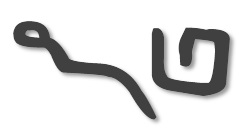
The Hebrew biliteral root B-N
The Hebrew word 

 (beyt) is, as we mentioned, an image of the home. The letter
(beyt) is, as we mentioned, an image of the home. The letter  (nun), a Hebrew word meaning "continue," in its original pictographic script is an image of a "seed," and represents the idea of "continuing" as the seed continues the next generation. When these two letters are combined we have the "the home continues" and is descriptive of a "son," the one who continues the home.
(nun), a Hebrew word meaning "continue," in its original pictographic script is an image of a "seed," and represents the idea of "continuing" as the seed continues the next generation. When these two letters are combined we have the "the home continues" and is descriptive of a "son," the one who continues the home.
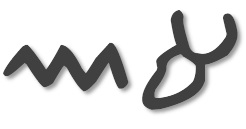
The Hebrew biliteral root A-M
The Hebrew word 

 (aleph) is the ox head representing "strength." The Hebrew letter
(aleph) is the ox head representing "strength." The Hebrew letter  (mem), a word meaning "water" in Hebrew, is an image of "water." When combined these two letters mean "strong water" which is "glue" and is the Hebrew word for "mother," the one who is the "glue" of the family.
(mem), a word meaning "water" in Hebrew, is an image of "water." When combined these two letters mean "strong water" which is "glue" and is the Hebrew word for "mother," the one who is the "glue" of the family.
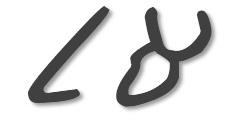
The Hebrew biliteral root A-L
The Hebrew word 

 (aleph), the picture of an ox, represents strength and the
(aleph), the picture of an ox, represents strength and the  (lamed) is a picture of a shepherd staff representing "authority." These letters form the Hebrew word meaning the "the strong authority" and is the Hebrew word for God.
(lamed) is a picture of a shepherd staff representing "authority." These letters form the Hebrew word meaning the "the strong authority" and is the Hebrew word for God.
Rabbi Matityahu Clark on bi-literal roots
All Hebrew linguists recognize that most Hebrew words are derived from a triliteral (or three letter) root. However, there are some linguists who have suggested that these triliteral roots are themselves derived out of a Biliteral (or two letter) root.
Rabbi Matityahu Clark, in his book Etymological Dictionary of Biblical Hebrew, records and organizes Rabbi Samson Raphael Hirsch's commentaries of the Bible which relate to the Hebrew language. Rabbi Clark stated; "The second major analytical tool in the Hirsch system we will call Gradational Variants. This involves five special consonants: א (aleph), ה (hey), ו (waw), י (yud) and נ (nun). These consonants play a special role with respect to roots whose third consonant is identical with the second. The new root form does not change the basic meaning of the original root, but adds some nuances of meaning."
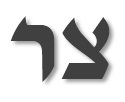
The Hebrew biliteral root Ts-R (In Modern Hebrew)
Rabbi Clark then provides many of examples of these "Gradational Variants" including; the triliteral root צרר (tsarar), which means "forcing, constraining, oppressing." As mentioned, the second and third consonants are identical, the letter ר (resh). The Gradiant Variants of צרר (tsarar) are; נצר (natsar) - guarding or protecting; יצר (yatsar) - forming or creating; צור (tsur) - fencing or enclosing.
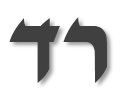
The Hebrew biliteral root R-D (In Modern Hebrew)
The meaning of the triliteral root רדד (radad) is a "flattening down or submitting totally." The Gradiant Variants are; רדה (radah) - ruling over or having dominion over; ירד (yarad) - going down; רוד (rud) – humbling.
Wilhelm Gesenius on bi-literal roots
Wilhelm Gesenius, one of the greatest Hebrew scholars of all time, wrote in his book Gesenius Hebrew Grammar, "..a large number of triliteral stems really point to a biliteral base, which may be properly called a root, since it forms the starting-point for several triliteral modifications of the same fundamental idea."
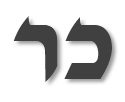
The Hebrew biliteral root K-R (In Modern Hebrew)
Gesenius then cites the following example; "The biliteral root כר (K-R) is the root of כרר (K-R-R), אכר (A-K-R), כור (K-W-R) and כרה (K-R-H), each being related to the idea of "digging." Another example he provides is the biliteral root דך (D-K), the root of דכא (D-K-A), דכך (D-K-K), דוך (D-W-K) and דכה (D-K-H), each being related to the idea of "striking" or "breaking."
Edward Horowitz states in his book How the Hebrew Language Grew, "Scholars are fairly convinced that back of these three lettered roots lie old primitive two-lettered syllables. These two-lettered syllables represent some simple primitive action or thing. It does seem quite clear that there existed a bi-literal or two-letter base for many, if not most, of our three lettered roots."
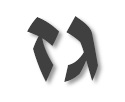
The Hebrew biliteral root G-Z (In Modern Hebrew)
Horowitz then provides the following roots, גוז (G-W-Z), גזר (G-Z-R), גזע (G-Z-A), גזז (G-Z-Z) and גזה (G-Z-H), each meaning to "cut," and all coming from the root גז (GZ) meaning to "shear." Horowitz noted, "Do not be surprised if so many of these comparatively few two-lettered roots mean to cut, to split, to slit, or slice. After all, everything that primitive man did in the way of making a living for himself and his family in some way or other involved a cutting action."

Like what you’re discovering? Continue the journey from Bible reader to translator.
|



